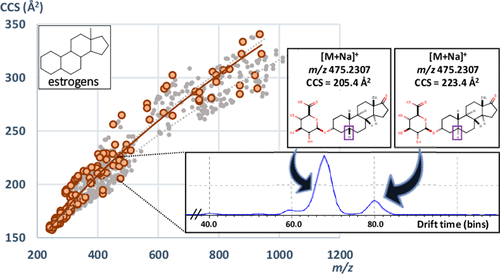- Acknowledgements: M.H.-M. wishes to express his appreciation to Fundación Ramón Areces (Spain) for a postdoctoral fellowship.
- Authors: M. Hernández-Mesa , B. Le Bizec, F. Monteau, A.M. García-Campaña, G. Dervilly-Pinel.
- Reference: Analytical Chemistry 90 (2018) 4616–4625.
Ion mobility spectrometry enhances the performance characteristics of liquid chromatography–mass spectrometry workflows intended to steroid profiling by providing a new separation dimension and a novel characterization parameter, the so-called collision cross section (CCS). This work proposes the first CCS database for 300 steroids (i.e., endogenous, including phase I and phase II metabolites, and exogenous synthetic compounds), which involves 1080 ions and covers the CCS of 127 androgens, 84 estrogens, 50 corticosteroids, and 39 progestagens. This large database provides information related to all the ionized species identified for each steroid in positive electrospray ionization mode as well as for estrogens in negative ionization mode. CCS values have been measured using nitrogen as drift gas in the ion mobility cell. Generally, direct correlation exists between mass-to-charge ratio (m/z) and CCS because both are related parameters. However, several steroids mainly steroid glucuronides and steroid esters have been characterized as more compact or elongated molecules than expected. In such cases, CCS results in additional relevant information to retention time and mass spectral data for the identification of steroids. Moreover, several isomeric steroid pairs (e.g., 5β-androstane-3,17-dione and 5α-androstane-3,17-dione) have been separated based on their CCS differences. These results indicate that adding the CCS to databases in analytical workflows increases selectivity, thus improving the confidence in steroids analysis. Consequences in terms of identification and quantification are discussed. Quality criteria and a construction of an interlaboratory reproducibility approach are also reported for the obtained CCS values. The CCS database described here is made publicly available.




